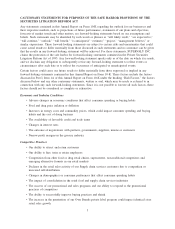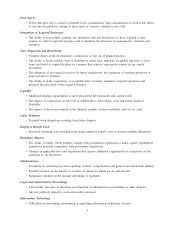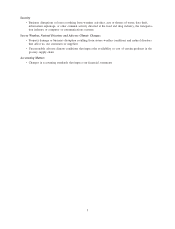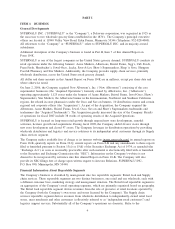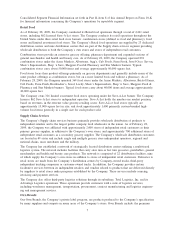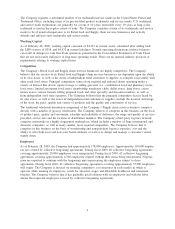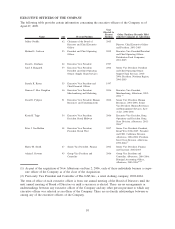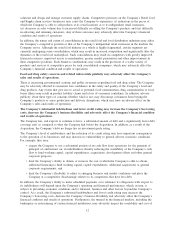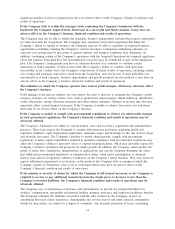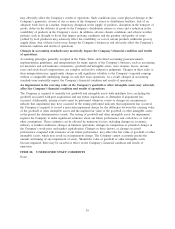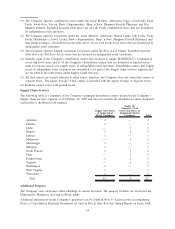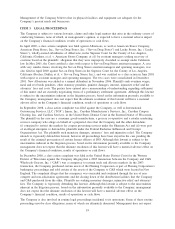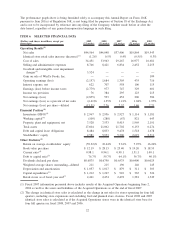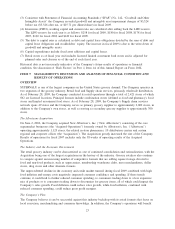Albertsons 2009 Annual Report Download - page 17
Download and view the complete annual report
Please find page 17 of the 2009 Albertsons annual report below. You can navigate through the pages in the report by either clicking on the pages listed below, or by using the keyword search tool below to find specific information within the annual report.credit in the future. There can be no assurances that government responses to the disruptions in the financial
markets will stabilize the markets or increase liquidity and the availability of credit.
The Company’s inability to successfully negotiate with labor unions or to maintain good labor relations
may lead to labor disputes and the disruption of the Company’s businesses, which may adversely affect
the Company’s financial condition and results of operations.
A large number of the Company’s employees are unionized, and the Company’s relationship with unions,
including labor disputes or work stoppages, may affect the sale and distribution of the Company’s products
and have an adverse impact on the Company’s financial condition and results of operations. As of February 28,
2009, the Company is a party to 266 collective bargaining agreements covering approximately 110,000 of its
employees, of which 47 covering approximately 37,000 employees are scheduled to expire in fiscal 2010.
These expiring agreements cover approximately 34 percent of the Company’s union-affiliated employees. In
addition, during fiscal 2009, 62 collective bargaining agreements covering approximately 4,500 employees
expired without their terms being renegotiated. Negotiations are expected to continue with the bargaining units
representing the employees subject to those agreements. In future negotiations with labor unions, the Company
expects that, among other issues, rising healthcare, pension and employee benefit costs will be important
topics for negotiation. There can be no assurance that the Company will be able to negotiate the terms of any
expiring or expired agreement in a manner acceptable to the Company. Therefore, potential work disruptions
from labor disputes may result, which may disrupt the Company’s businesses and adversely affect the
Company’s financial condition and results of operations.
Escalating costs of providing employee benefits may adversely affect the Company’s financial condition
and results of operations.
The Company provides health benefits to and sponsors defined pension and other post-retirement plans for
substantially all employees not participating in multi-employer health and pension plans. The Company’s costs
to provide such benefits continue to increase annually. In addition, the Company participates in various multi-
employer health and pension plans for a majority of its unionized employees, and the Company is required to
make contributions to these plans in amounts established under collective bargaining agreements. The costs of
providing benefits through such plans have escalated rapidly in recent years and contributions to these plans
may continue to create collective bargaining challenges. The amount of any increase or decrease in the
Company’s required contributions to these multi-employer plans will depend upon many factors, including the
outcome of collective bargaining, actions taken by trustees who manage the plans, government regulations, the
actual return on assets held in the plans and the potential payment of a withdrawal liability if the Company
chooses to exit a market. Increases in the costs of benefits under these plans coupled with adverse stock
market developments that have reduced the return on plan assets have caused some multi-employer plans in
which the Company participates to be underfunded. The unfunded liabilities of these plans may result in
increased future payments by the Company and the other participating employers, including costs that may
arise with respect to any potential litigation or that may cause the acceleration of payments to fund any
underfunded plan. The Company’s risk of such increased payments may be greater if any of the participating
employers in these underfunded plans withdraws from the plan due to insolvency and is not able to contribute
an amount sufficient to fund the unfunded liabilities associated with its participants of the plan. If the
Company is unable to control healthcare and pension costs, the Company may experience increased operating
costs, which may have a material adverse effect on the Company’s financial condition and results of
operations.
The Company’s inability to open and remodel a significant number of stores as planned may have an
adverse effect on the Company’s financial condition and results of operations.
In fiscal 2010, pursuant to the Company’s 2010 capital plan, the Company expects to complete 75 to 80 major
store remodels, 30 to 40 minor store remodels, three new combination and food stores, and 50 to 60 limited
assortment stores, including licensed stores. If, as a result of labor relations issues, supply issues or
environmental and real estate delays, a significant portion of these capital projects do not stay reasonably
within the time and financial budgets that the Company has forecasted, the Company’s financial condition and
results of operations may be adversely affected. Furthermore, the Company cannot ensure that the new or
remodeled stores will achieve anticipated results. As a result, the Company’s inability to open and remodel a
13


